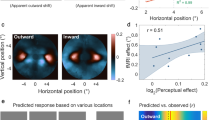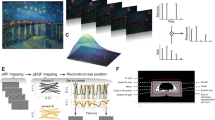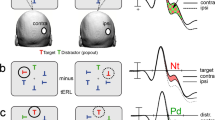Abstract
Here we identify a neural correlate of the ability to precisely direct visual attention to locations other than the center of gaze. Human subjects performed a task requiring shifts of visual attention (but not of gaze) from one location to the next within a dense array of targets and distracters while functional MRI was used to map corresponding displacements of neural activation within visual cortex. The cortical topography of the purely attention-driven activity precisely matched the topography of activity evoked by the cued targets when presented in isolation. Such retinotopic mapping of attention-related activation was found in primary visual cortex, as well as in dorsomedial and ventral occipital visual areas previously implicated in processing the attended target features. These results identify a physiological basis for the effects of spatially directed visual attention.
This is a preview of subscription content, access via your institution
Access options
Subscribe to this journal
Receive 12 print issues and online access
$209.00 per year
only $17.42 per issue
Buy this article
- Purchase on Springer Link
- Instant access to full article PDF
Prices may be subject to local taxes which are calculated during checkout





Similar content being viewed by others
References
von Helmholtz, H. Treatise on Physiological Optics Vol. III (Dover, New York, 1910).
James, W. The Principles of Psychology Vol. I (Classics of Psychiatry and Behavioral Sciences Library, Birmingham, 1890).
LaBerge, D. Spatial extent of attention to letters and words. J. Exp. Psychol. Hum. Percept. Perform. 9, 371–379 (1983).
Crick, F. Function of the thalamic reticular complex: The searchlight hypothesis. Proc. Natl. Acad. Sci. USA 81, 4586– 4590 (1984).
Duncan, J. Selective attention and the organization of visual information. J. Exp. Psychol. Gen. 113, 501–517 (1984).
Posner, M. I. & Petersen, S. E. The attention system of the human brain. Annu. Rev. Neurosci. 13, 25–42 (1990).
Crick, F. The Astonishing Hypothesis: The Scientific Search for the Soul (Scribner, New York, 1994).
Luck, S. J. & Hillyard, S. A. The role of attention in feature detection and conjunction discrimination: an electrophysiological analysis. J. Neurosci. 80, 281–297 (1995).
Desimone, R., Wessinger, M., Thomas, L. & Schneider, W. Attentional control of visual perception: cortical and subcortical mechanisms. Cold Spring Harbor Symp. Quant. Biol. 55, 963–971 (1990).
Corbetta, M. et al. Selective and divided attention during visual discrimination of shape, color, and speed: functional anatomy by positron emission tomography. J. Neurosci. 11, 2383– 2402 (1991).
Corbetta, M., Miezin, F. M., Shulman, G. L. & Petersen, S. E. A PET study of visuospatial attention. J. Neurosci. 13, 1202–1226 (1993).
Motter, B. C. Neural correlates of attentive selection for color or luminance in extrastriate area V4. J. Neurosci. 14, 2178– 2189 (1994).
Treue, S. & Maunsell, J. H. R. Attentional modulation of visual motion processing in cortical areas MT and MST. Nature 382, 539–541 (1996).
Beauchamp, M. S., Cox, R. W. & DeYoe, E. A. Graded effects of spatial and featural attention on human area MT and associated motion processing areas. J. Neurophysiol. 78, 516–520 (1997).
O'Craven, K. M. et al. Voluntary attention modulates fMRI activity in human MT-MST. Neuron 18, 591– 598 (1997).
Kastner, S., De Weerd, P., Desimone, R. & Ungerleider, L. G. Mechanisms of directed attention in the human extrastriate cortex as revealed by functional MRI. Science 282, 108– 111 (1998).
McAdams, C. J. & Maunsell, J. H. R. Effects of attention on orientation-tuning function of single neurons in macaque cortical area V4. J. Neurosci. 19, 431– 441 (1999).
Hillyard, S. A. Combining steady-state visual evoked potentials and fMRI to localize brain activity during selective attention. Hum. Brain Mapp. 5, 287–292 (1997).
Heinze, H. J. et al. Combined spatial and temporal imaging of brain activity during visual selective attention in humans. Nature 372, 543–546 (1994).
Mangun, G. R. et al. Covariations in ERP and PET measures of spatial selective attention in human extrastriate visual cortex. Hum. Brain Mapp. 5, 273–279 (1997).
Woldorf, M. G. et al. Retinotopic organization of early visual spatial attention effects as revealed by PET and ERPs. Hum. Brain Mapp. 5, 280–286 (1997).
Schneider, W., Noll, D. C. & Cohen, J. D. Functional topographic mapping of the cortical ribbon in human vision with conventional MRI scanners. Nature 365, 150–153 (1993).
Sereno, M. I. et al. Borders of multiple visual areas in humans revealed by functional MRI. Science 268, 889–893 (1995).
DeYoe, E. A. et al. Mapping striate and extrastriate visual areas in human cerebral cortex. Proc. Natl. Acad. Sci. USA 93, 2382–2386 (1996).
Engel, S. A., Glover, G. H. & Wandell, B. A. Retinotopic organization in human visual cortex and the spatial precision of functional MRI. Cereb. Cortex 7, 181–192 (1997).
Talairach, J. & Tournoux, P. Co-Planar Stereotaxic Atlas of the Human Brain (Thieme, New York, 1988).
Desimone, R. & Schein, S. J. Visual properties of neurons in area V4 of the macaque: Sensitivity to stimulus form. J. Neurophysiol. 57, 835–868 (1987).
Lueck, C. J. et al. The colour centre in the cerebral cortex of man. Nature 340, 386–389 (1989).
Schein, S. J. & Desimone, R. Spectral properties of V4 neurons in the macaque. J. Neurosci. 10, 3369– 3389 (1990).
Beauchamp, M. S., Haxby, J. V., Jennings, J. & DeYoe, E. A. An FMRI adaptation of the Farnsworth-Munsell 100 hue test reveals human color-selective areas. Cereb. Cortex (in press).
Hadjikhani, N. et al. Retinotopy and color sensitivity in human visual cortical area V8. Nat. Neurosci. 1, 235– 241 (1998).
He, S., Cavanagh, P. & Intriligator, J. Attentional resolution and the locus of visual awareness. Nature 383, 334–337 (1996).
Tootell, R. B. H. et al. The retinotopy of spatial attention. Neuron 21, 1409–1422 (1998).
DeYoe, E. A., Neitz, J., Miller, D. & Wieser, J. Functional magnetic resonance imaging (FMRI) of visual cortex in human subjects using a unique video graphics stimulator. Proc. Soc. Magn. Reson. Med. 3, 1394 (1993).
Treisman, A. M. Perceptual grouping and attention in visual search for features and for objects. J. Exp. Psychol. Hum. Percept. Perform. 8, 194–214 (1982).
Bandettini, P. A., Jesmanowicz, A., Wong, E. C. & Hyde, J. S. Processing strategies for functional MRI of the human brain. Magn. Reson. Med. 30, 161–173 (1993).
Saad, Z. S., DeYoe, E. A. & Ropella, K. M. in Proceedings of the 19th International Conference - IEEE.EMBS 460–463 (Chicago, Illinois, 1997).
Acknowledgements
Our thanks to Jon Wieser for technical assistance. Supported by NIH grants EY10244 and MH51358 to EAD and a Keck Foundation grant to the Medical College of Wisconsin.
Author information
Authors and Affiliations
Corresponding author
Rights and permissions
About this article
Cite this article
Brefczynski, J., DeYoe, E. A physiological correlate of the 'spotlight' of visual attention. Nat Neurosci 2, 370–374 (1999). https://doi.org/10.1038/7280
Received:
Accepted:
Issue Date:
DOI: https://doi.org/10.1038/7280
This article is cited by
-
Lack of orientation specific adaptation to vertically oriented Glass patterns in human visual cortex: an fMRI adaptation investigation
Scientific Reports (2023)
-
Attention rhythmically samples multi-feature objects in working memory
Scientific Reports (2022)
-
Periodic attention operates faster during more complex visual search
Scientific Reports (2022)
-
Preparatory attention to visual features primarily relies on non-sensory representation
Scientific Reports (2022)
-
The time-course of feature-based attention effects dissociated from temporal expectation and target-related processes
Scientific Reports (2022)



